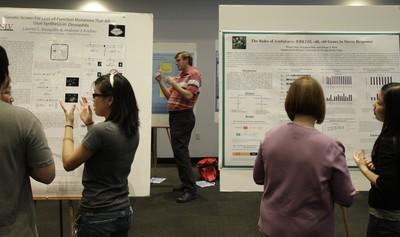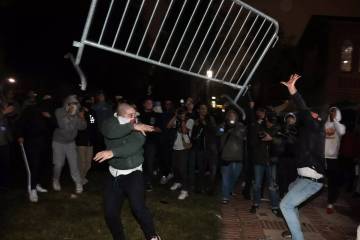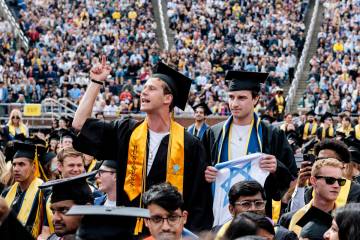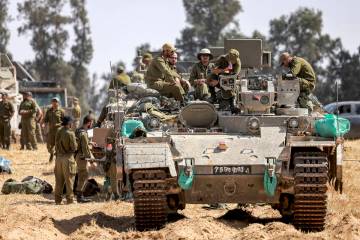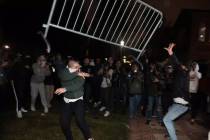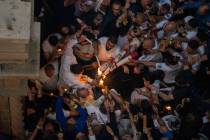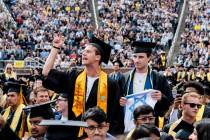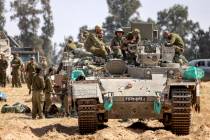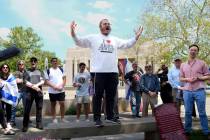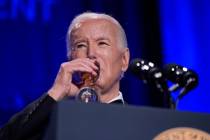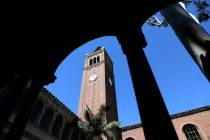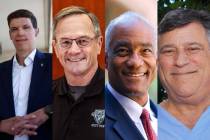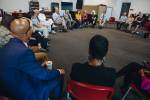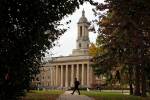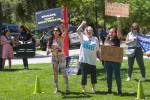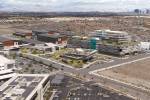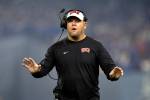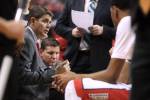UNLV gets national attention
Yalemi Morales, a precocious sophomore at the University of Nevada, Las Vegas, has been working on ways to kill cancer cells this summer, thanks to a federal grant that allows her to partner with the Nevada Cancer Institute for her research.
A poster showing the results of her work -- she hasn't found a solution just yet -- is a dizzying array of numbers, letters and symbols that one might expect out of a graduate or doctoral student.
If Morales would have been at UNLV a decade ago, she probably would have had to go out of state for her research because UNLV offered only about a dozen of the summer-long undergraduate research spots instead of the 50 or so now.
Morales is part of a surging College of Sciences that has grown by leaps and bounds and is capturing national attention in the form of scientific articles and exclusive federal grants and awards.
Between 1991 and 2001, UNLV was the fourth-fastest-growing university in the nation by measure of its output of articles in the sciences and engineering fields, according to a recent study by the National Science Foundation.
Publication of peer-reviewed articles, considered a key measure of productivity by a university, grew 99 percent at UNLV during that period.
As other universities grow stagnant or cut back on expensive scientific research, UNLV has been able to capitalize by luring top young professors and researchers.
The college's growth has been flying in the face of a worrying national trend, the National Science Foundation said. The United States has seen its growth in the number of scientific publications plateau over the past 10 years as Europe and Asia have seen an increase.
"It's a difficult picture," UNLV College of Engineering Dean Eric Sandgren said of the report. "The fact that our (national) output has flattened out is not good. But for us, it's a very positive thing."
The College of Sciences has undergone a metamorphosis thanks to rapid growth and a new focus on research, faculty and professors said.
Postdoctoral scholars, for example, the top tier of students who have completed their doctoral degree and conduct research under a professor's tutelage, were unheard of at UNLV 20 years ago, faculty said. Now, the university has enough top faculty to oversee dozens of "post-docs."
In the area of publicized articles, the increase in quantity has brought with it a boost in quality.
Faculty are being published in the most prestigious peer-reviewed publications, and gossip circulates whenever someone publishes in something lesser, said Carl Reiber, associate dean of academic affairs for the School of Life Sciences.
The transformation was the goal of former UNLV President Carol Harter, who took over in 1995 what she called a "regional teaching institution."
"She was really the first person who came in and said, 'We're going to be a research university,' " College of Sciences Dean Ron Yasbin said.
University officials are quick to point out that it is classified as a research university with high research activity from the Carnegie Foundation for the Advancement of Teaching.
Integral to becoming a research university has been hiring research-oriented faculty, made easier by the fact that UNLV has been one of the few universities in the country growing rapidly and offering well-paying jobs.
Science faculty such as Brian Hedlund, an assistant professor who was hired in 2003 and has received a prestigious NSF Early Career Development Award for his work discovering new organisms in Nevada's hot springs, have catapulted the university to a national level.
Researchers are receiving highly competitive grants on a consistent basis, and 2007 has proven to be the best year in the College of Sciences' history.
This year, it has collected more than $10 million from the NSF, National Institutes of Health, the Department of Agriculture, Department of the Interior and Department of Energy.
The trend toward a research university sets off chain reaction that benefits students: better faculty receive better funding, which creates better labs and access for students.
UNLV isn't to the point where it can afford for faculty to not teach classes, said Michelle Elekonich, a UNLV assistant professor who has been involved projects such as the honeybee genome project.
That means that undergraduates, unlike at more prestigious institutions, have better access to top faculty.
Growth at UNLV has slowed in recent years. And like universities throughout the country, UNLV is facing a crisis in which fewer young people, minorities in particular, are entering the science and engineering fields.
"It's a serious problem," Yasbin said. "We're not doing enough."
The university recently has established the Center for Mathematics and Science Education and has been making strides in developing new ways to teach students, he said.
Science and engineering still suffers a image that the fields are nerdy, Sandgren said.
The space race of the 1960s and the Cold War that followed boosted the prominence of engineering. He is hopeful the energy crisis will have a similar effect on the field.
GROWING UP The University of Nevada, Las Vegas, roughly doubled its output of scientific and engineering articles since the early 1990s, according to a recent study by the National Science Foundation. Below are the largest rates of growth and steepest declines among the top 200 universities in the United States between 1991 and 2001: LARGEST GROWTH • Drew University of Medicine and Science, 127% • Florida A&M University, 116% • Clark Atlanta University, 101% • UNLV, 99% • University of Montana, 89% STEEPEST DECLINE • MCP Hahnemann University. -46% • Virginia Tech. -31%• University of Dayton, -29% • Drexel University, -28% • SUNY Health Science Center at Brooklyn, -28% Source: National Science Foundation



